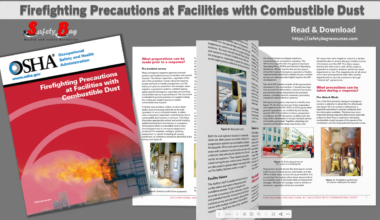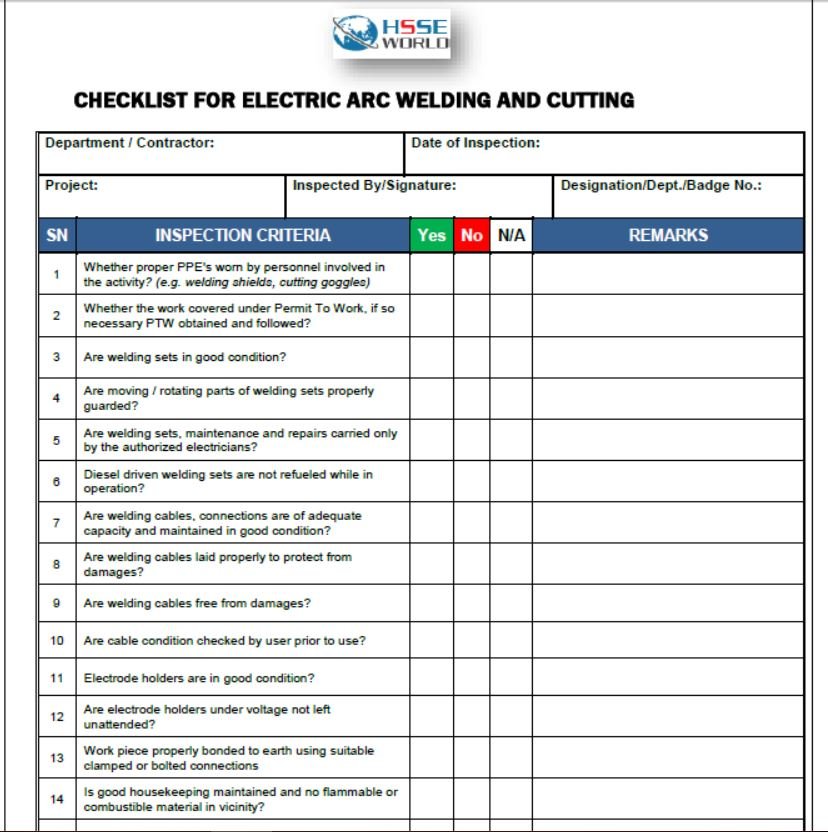A construction site safety inspection carries a lot of weight and responsibility, not only for the agents but also for the workers and project managers. These inspections are crucial to ensure that the project is proceeding safely and efficiently. Residential and commercial projects alike are required to have routine inspections so that any violations or mismanagements can be corrected before the completion date.
Below is a sample document ( construction safety Inspection checklist ) provided to assist employers in developing programs tailored to their own operations. We encourage employers to copy, expand, modify and customize this sample as necessary to accomplish this goal.
This document is provided as a compliance aid but does not constitute a legal interpretation of OSHA Standards, nor does it replace the need to be familiar with, and follow, the actual OSHA Standards.
Read the the Construction Safety Inspection Checklist by Flipping checklist firle below :
Note: This checklist is by no means all-inclusive. You should add to it or delete items that do not apply to your business; however, carefully consider each item and then make your decision. You should refer to OSHA Standards for the Construction Industry 29 CFR Part 1926 for specific requirements that may apply to your work situation. This checklist is typical for construction industries, but not for general or maritime industries.
Also Read: Workplace Safety Inspections Forms
Still, there are more benefits than drawbacks to having an inspection done throughout every stage of your project.
1. Hazard Identification
As a project manager, safety for your workers is your No. 1 concern. Not only do construction inspections identify the safest roads for equipment and keep your workers safe, they also help identify the potential hazards that could occur along the way. You’re able to take precautions and prepare correctly so that your workers are safe, the site isn’t compromised by nature or human error, and you can continue without delay. Being on alert and aware of the potential dangers will also keep your team focused while working on the job site.
2. Improved Construction Quality
You take pride in the quality of work that you and your team produce, but in order to maintain your high standards, you need to understand where you’re lacking. Having an inspection performed throughout the construction process will guarantee that you are sticking to existing regulations and codes. If there is a change in code throughout your project, an inspector can guide you through the necessary changes, keeping your quality of work at its highest. In the end, your client will be left with a well-built, sound structure.
3. Encourages Environmentally Friendly Sites
Part of an agent’s role is to monitor the environmental impact that your project is having on the surrounding land, lakes, streams, and wildlife. There are detailed policies for construction sites, and an inspector can keep you on track with those regulations. They will monitor your use of fuel, how trash is discarded or recycled, and where you’re dumping waste. This will ensure that your team is vigilant in their cleanup and that the environmental impact is minimal.
The content of the Construction Safety Inspection Checklist
- Jobsite General……3
- Housekeeping and Sanitation ………3
- Hazard Communication …………4
- Fire Prevention ………4
- Flammable Liquids/Materials …….4
- Electrical ………5
- Personal Protective Equipment (PPE) ……5
- Hand Tools ………5
- Power Tools……6
- Ladders ………6
- scaffolds …………6
- Excavation and Shoring ………7
- Tunneling ………7
- Hoists, Cranes, and Derricks ……7
- Heavy Equipment ………8
- Motor Vehicles ………8
- Garages and Repair Shops ………8
- Barricades ………9
- Handling and Storage of Materials ………9
- Demolition ………9
- Blasting ………9
- Welding and Cutting ………10
- Steel Erection ………10
- Concrete Construction …………11
- Masonry ………11
- Highway Construction ………11
- Asbestos ………11
- Work Permits ………11
- Construction Area – Secured Access or After-Hours ………12
Also, Read Hazard Identification Plan (HIP) Template
Download The Forms
Construction Safety Inspection Checklist
More Downloads
- Welding, Cutting, and Brazing Checklist
- Construction Safety Inspection Checklist
- Permit To work Forms
- Hazard Identification Plan (HIP) Template
- Pre-Startup Safety Review Checklist (PSSR)
- 35 Inspection forms for Rig Check
- Chemical Risk Assessment form
- 22-Safety Inspection Checklists
- Safety Task Assessment Form
- Suspended Scaffold Pre-Operation Inspection Checklist
- Grating-Decking-Floor- handrail-Removal Form
- Electrical Inspection Checklists
- Annual Internal Audit Form
- Mobile Scaffold Inspection checklist
- Simultaneous Operation (SIMOPS) checklist
- Temporary Construction Facilities (TCF) Inspection checklist
- HIRA, HSE Hazards & Effects Management Process (HEMP) & Risk Register Template
- Ladder Inspection Form
- Construction safety Inspection checklist
- Equipment Safe Operating Procedures- SOP 61 checklist
- Permit to Work (PTW ) AUDIT CHECKLIST
- Hygiene and Sanitation Inspection Checklist
- Electric Arc Welding and Cutting Checklist
- Pressure Testing Checklist
- Crane Suspended Personnel Platform (MANBASKET) Permit
- Laboratory Inspection Checklist Form
- CRANE INSPECTION REPORT
- Scaffold Register and Inspection Checklist
- Portable Ladder Self Inspection checklist
- Process Safety Management (PSM) Compliance checklist
- OSHA Inspection Checklist 8-Pages
- Job Hazard Analysis form
- Incident Report Form
- Safety Inspection Form
- Contractor Weekly HSE Report Form
- Competent Person Designation form
- Compressed Gas Cylinders Access Control Inspection Checklist
- Emergency Drill After Action Review form
- Emergency Drill Table Top meeting Form
- Slips,Trips and Falls checklist
- Lift Plan Form
- Machines Access Control Inspection Checklists
- Camp Inspection form


